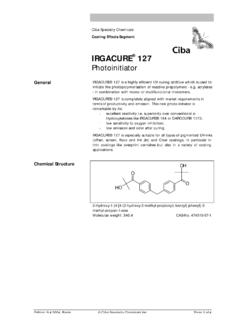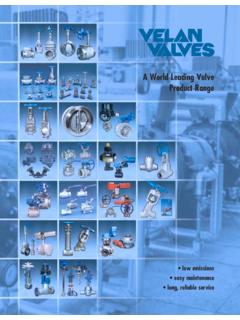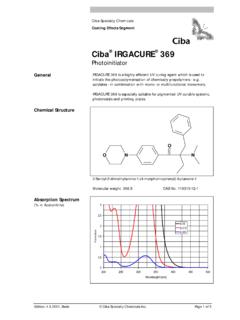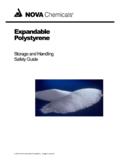Transcription of TABLE OF CONTENTS - Specialty Chemicals
1 TABLE OF CONTENTSA bout the Company 1 Our Promise 1 Sekisui Specialty Chemicals 1 Introduction 2 Environmental, Health, and Safety 2 FDA Compliance 2 Polyvinyl Alcohol 3 Selvol Polyvinyl Alcohol General Properties 4 Solubility 4 Surface Tension 5 Foaming 5 Preservation 5 Specific Gravity 5 Polyvinyl Alcohol Business 6 Standard & Specialty Grade TABLE 7 Selvol Polyvinyl Alcohol as a Protective Colloid 8 General Recipe and Procedure 8 Effect of PVOH Molecular Weight on Emulsion Properties 9-10 Selvol PVOH 418 11 Selvol PVOH 800 Grades for Emulsion Polymerization 12 Hints for using PVOH as a Protective Colloid in Emulsion Polymerization 13 About the CompanyThe Sekisui chemical Group is a global company that operates in
2 Three major businesses: High Performance Plastics, Urban Infrastructure and Environmental Products, and Housing. Founded in 1947 and currently headquartered in Osaka and Tokyo, Japan, Sekisui strives to deliver a wide range of products and services to enrich people s lives and the social Specialty Chemicals Sekisui produces and sells one of the most complete lines of polyvinyl alcohol in the world. Since the introduction of Selvol Polyvinyl Alcohol, we have developed a high level of expertise in both the production and use of PVOH. Based in Dallas, Texas, Sekisui Specialty Chemicals is a leading polyvinyl alcohol supplier with manufacturing facilities in Calvert City, Kentucky, Pasadena, Texas and Tarragona, Spain.
3 The combined capacity of the three plants makes Sekisui a leading global merchant supplier of polyvinyl s commitment to polyvinyl alcohol is especially evident in our research and applications support activities. We have one of the largest technical services, product application, and analytical services groups in the world. Research and application development is carried out at our facilities in Houston, Texas. Sekisui also has a global sales force located in offices worldwide to respond more quickly to the needs of our ,TEXASCALVERT CITY,KENTUCKYTARRAGONA,SPAINDALLAS, TEXASOur PromiseThrough prominence in technology and quality, Sekisui chemical Group will contribute to improving the lives of the people of the world and the Earth s environment, by continuing to open up new frontiers in residential and social infrastructure creation and chemical solutions.
4 Architectural GlassUrban Intrastructure and Environmental ProductHousing1 Selvol Polyvinyl AlcoholSelvol Polyvinyl Alcohol is a white, granular, water-soluble resin manufactured by polymerizing vinyl acetate and hydrolyzing the resultant polymer to produce the alcohol (Figure 1). Because PVOH is synthesized from polyvinyl acetate, a variety of different grades of Selvol Polyvinyl Alcohol is available that varies in molecular weight and hydrolysis level. These two factors are the major determinants of the performance properties of PVOH. Hydrolysis level is a measure of the mole % hydroxyl functionality on the polymer. The hydrolysis level of PVOH is typically categorized as shown in TABLE = mole %y = 1-12 more %FIGURE 1: General Structure of Polyvinyl Alcohol(CH2 CH)x (CH2 CH)y|OH|O|C = O|CH3 TABLE 2: Selvol Polyvinyl Alcohol Molecular WeightViscosity 1 (cP)Viscosity TypeDegree of PolymerizationAverage WeightMolecular Weight RangeNumber AverageMolecular Weight Range3-6 Low150 - 65013,000 - 50,0007,000 - 23,00022-30 Medium1000 - 150085,000 - 124,00044,000 - 65,00045-72 High1600 - 2200146,000 - 186,00070,000 - 101,0001 4% aqueous solution Mole % + 3.
5 Description of the Different Hydrolysis Levels for PVOHM olecular weight is a measure of polymer chain length and is typically reported as a 4% aqueous solution viscosity ( TABLE 2). IntroductionThis brochure reviews polyvinyl alcohol as a protective colloid for the emulsion polymerization of polyvinyl acetate. For more detailed information on specific applications, the preparation of polyvinyl alcohol solutions, please refer to our other brochures, visit our website at , or call our Product Information Center at + , Health, and SafetyPlease refer to our Material Safety Data Sheets (MSDSs) or Safety Data Sheets (SDSs) for information on the safe use and handling of Selvol Polyvinyl Alcohol, including toxicity, fire, and explosion hazards, as well as environmental effects.
6 An MSDS can be obtained online at CompliancePolyvinyl alcohol is used in many food contact applications, including food packaging adhesives and coatings for paper and paperboard. For more specific information on the FDA status of any of our grades, please contact our Product Information Center at + NumberSelvol Polyvinyl Alcohol Super and Fully Hydrolyzed Partially and Intermediate Hydrolyzed9002-89-525213-24-5 Water7732-18-5 Methanol67-56-1 Sodium Acetate127-09-3 TABLE 1: Selvol Polyvinyl Alcohol Right-to-Know InformationMolecular Structure PVOH23 Selvol Polyvinyl Alcohol General PropertiesSOLUBILITYAll Selvol PVOH grades are readily soluble in water.
7 Other solvents include dimethyl sulphoxide, acetamide, glycols, and dimethyl formamide. The conditions for dissolution of PVOH in water are primarily governed by the degree of hydrolysis, but they are also influenced by molecular weight, particle size distribution, and solubility occurs with PVOH grades that have a hydrolysis level between 87-89%. Grades in this range are highly soluble in cold water. However, for total dissolution, it is recommended that, after the PVOH is added to the water, it must be heated to 185-190 F and held at this temperature for 30 minutes. Higher hydrolysis grades require higher temperatures (200-205 F) because of the increased hydrogen bonding associated with its lower acetate levels.
8 Please refer to our Selvol Polyvinyl Alcohol Solution Preparation Guidelines for additional TENSIONB ecause PVOH contains both hydrophilic hydroxyl groups and hydrophobic acetate groups, these compounds have some surface activity. This results in aqueous PVOH solutions having surface tension values lower than those of pure water. The surface tension of PVOH solutions varies with concentration, temperature, degree of hydrolysis, and molecular weight. In general, the lower the hydrolysis level, the lower the surface tension of the aqueous solution, as shown in Figure 2. Surface tension also varies when comparing grades of equal hydrolysis level but different molecular weight (Figure 3).
9 In this case, materials of lower molecular weight have slightly lower surface tension values. FOAMINGA queous solutions of PVOH, because of their low surface tension, have a tendency to foam. Foaming is dependent on the level of hydrolysis, as well as the mechanical dynamics unique to each preparation and end use. Partially hydrolyzed grades of PVOH are more susceptible to foaming than solutions of PVOH with higher degrees of hydrolysis. In order to minimize foaming, the following suggestions should be followed:1. Agitation should be sufficient to move the water surface without whipping air into the system2. PVOH solutions should not be boiled.
10 3. Recirculation and/or feed lines should not be placed so they introduce air into the addition to following the above guidelines, it may also be necessary to add defoamers to the PVOH solution. TABLE 4 lists several recommended defoamers for use with PVOH solutions. The advantage of Selvol 800 grades is that little or no additional defoamer may be PVOH solutions are stored for longer than 24 hours before use, it is recommended that a biocide be added to prevent biocontamination. See TABLE 5 for recommended GRAVITYThe specific gravity of PVOH solutions depends on concentration and temperature, but is independent of PVOH grade. Figure 4 shows the specific gravity as a function of concentration at various LevelFC 407 ESP Enterprises<1%, d/dAntifoam 116 Harcros< 1%, d/dIndustrol DF 132 BASF< 1%, d/d* Note: The FDA compliance status of the recommended additives should be verified with the respective manufacturer.












